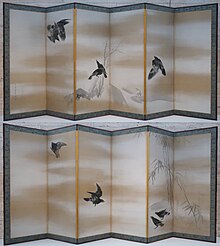Maruyama Ōkyo
Maruyama Ōkyo ( Japanese 円 山 応 挙 , actually 圓 山 應 擧 ; * June 12, 1733 , † August 31, 1795 ) was a Japanese painter .
life and work
Maruyama Ōkyo was born in Anou (today's Kameoka , Kyōto Prefecture) and went to Kyoto in his youth . He began his artistic career in the studio of Owariya Kanbei, where he decorated movable dolls and designed Western-influenced perspective pictures, so-called uki-e . Through additional training with the painter Ishida Yūtei (1721–1786) Ōkyo learned in the style of the Tsuruzawa school, a branch of the Kanō school , and secured first orders from high-ranking personalities from the Kyōto aristocracy. Under the long-standing patronage of the abbot Yūjō (1722–1773) in the Enman'in temple in Ōtsu (today's Shiga Prefecture), Ōkyo dealt with the concepts and techniques of Chinese, Japanese and Western art.
In his pictures he resorted to western naturalism , shadow and perspective techniques and eastern decorative design means and motif conventions. In the last years of his life between 1785 and 1795, Ōkyo concentrated on elaborate panel paintings in various temples such as the Daijōji in Kasumi, the Kongōji in his hometown of Kameoka, or the residence of the Shintō shrine Kotohira-gū on Shikoku .
Maruyama also created a series of woodcuts from a western perspective for viewing in a peep box . The series is printed in black and gray, but has often been hand-colored. In order to appear correctly when viewed in a peep box, the pages are printed mirror-inverted.
He is considered to be the founder of the Maruyama Shijō school , which among others Matsumura Goshun (1752-1811), Nagasawa Rosetsu (1754-1799), Komai Genki (1747-1797), his son Ōzui (1766-1829) and Oku Bunmei ( ? –1813) belonged to. Ōkyo and the Maruyama Shijō School exerted a great influence on the development of Nihonga painting in modern Japan.
Important works
- Unryū-zu byōbu ("Dragons in the Clouds"), 1773
- Tōka-zu byōbu ("wisteria"), 1766 ( Nezu Museum , Tokyo)
- Yukimatsu-zu byōbu ("snow on pines") ( Mitsui Memorial Museum , Tokyo), declared a national treasure ( 国宝 , kokuhō )
- Mizu-nomi no Tora Zu ("Water-Drinking Tiger"), 1782, Otani Memorial Art Museums, Nishinomiya
- Yūko-zu ("Tiger"), 1787 (panel paintings in Kotohira-gū, Shikoku)
- Hatō-zu ("waves"), 1788 (panel paintings of the Kongō-ji temple , for safekeeping in the Tokyo National Museum )
swell
- Guth, Christine ME Art of Edo Japan: The Artist and the City 1615-1868 . Harry N. Adams, Inc., New York 1996.
- Kanō Hiroyuki u. Minamoto Toyomune (Ed.). Maruyama Ōkyo gashū (2 volumes). Kyōto Shinbunsha, Kyōto 1997.
- McKelway, Matthew (Ed.). Traditions Unbound: Groundbreaking Painters of Eighteenth-Century Kyoto . The Asian Art Museum, San Francisco 2005.
- Sasaki Jōhei et al. Sasaki Masako. Maruyama Ōkyo kenkyū (2 volumes). Chūō Kōron Bijutsu Shuppan, Tōkyō 1996.
Web links
| personal data | |
|---|---|
| SURNAME | Maruyama, Ōkyo |
| ALTERNATIVE NAMES | 円 山 応 挙 (Japanese); Maruyama Masataka |
| BRIEF DESCRIPTION | Japanese painter |
| DATE OF BIRTH | June 12, 1733 |
| DATE OF DEATH | August 31, 1795 |




